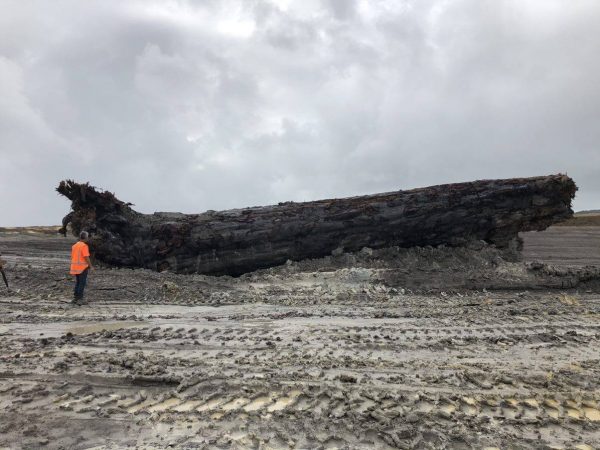Forty-One Thousand Year Old Tree Tells Of Earth’s Magnetic Reversal
The expansion of a geothermal power plant in Ngawha, on New Zealand’s North Island, has uncovered an ancient Kauri tree buried twenty-six feet down into the ground. When it was pulled up, it was discovered to be sixty-five feet long and eight feet wide.
The tree was alive about forty-one thousand years ago and stood for about fifteen hundred years. When scientists studied the tree rings, they found that, during the time the tree was alive, the earth had an almost complete reversal of its magnetic field.
Paleoclimatology and climate change expert from the University of New South Wales, Chris Turney, the head of the group of scientists studying the tree remarked that the Kauri tree was alive during the Laschamp Excursion.
A time, around forty-two thousand years ago when the magnetic field of the earth almost flipped—the north and south poles coming close to completely switching positions.
The tree lived over one and one-half millennia according to the rings. The Australian Research Council is sponsoring the research that includes measuring and studying radioactive carbon found in the rings.
According to the Kauri National Park Proposal and New Zealand Geographic, at one time Kauri forests covered almost two hundred and forty thousand acres across New Zealand until Europeans came in the 1700s and all but decimated the species.

In 1952, thanks to Professor Roy McGregor of the Auckland University College, the Waipoua Sanctuary was created under the protection of the Department of Conservation to shield as many trees as possible. The largest kauri tree in New Zealand resides there.
Measuring almost one hundred and sixty-nine feet tall and about forty-five feet wide, it has stood for one thousand five hundred years. During the 19th and 20th centuries, three thousand dams were built in New Zealand with Kauri wood mostly in the Waitākere Ranges, the Hokianga, and the Coromandel Peninsula.
The usefulness of the kauri tree has contributed to its difficulties. The trees easily adapt to poor soil conditions, and the gum they secrete to protect any injuries to the tree was used for varnish, linoleum, and other resin based items.
The logs were used in shipbuilding, roofing materials, and prefabricated homes for shipment to Sydney, Australia and San Francisco, California in the United States. After the earthquake and fires in 1906, kauri wood was used in rebuilding San Francisco.
There is a new threat to the ancient trees from a water mold called Phytophthora taxon Agathis that has been around since the 1970s.
The mold spores attack and damage the feeding roots, essentially starving the tree to death. There is no known cure; only prevention can keep the soil borne spores away, according to Teara.
Private donations and trusts have been established including Waipoua Forest Trust, Kauri 2000, and the Puketi Forest Trust, and are all sponsoring groups of volunteers to clean up and plant Kauri seedlings which will be protected.
Tane’s Tree Trust, founded in 2001, coordinates research and data sharing and lobbies the government to encourage native tree plantations on private lands.
According to Scientific American, the Earth’s magnetic pole occasionally reverses. First, the magnetic field begins to collapse; one time that happened was about seven hundred ninety-five thousand years ago.
The collapse periods are called excursions and the field drops to a small portion of its original strength but does not reverse.
The magnetic field recovered slightly about seven hundred eighty-four thousand years ago, then, eleven thousand years later, the poles reversed, a process that lasted four thousand years. The last excursion, the Laschamp event, occurred around forty-one thousand years ago.
This was learned by observing lava flows in the Clermont-Ferrand district of France. Brad Singer of the University of Wisconsin–Madison and his colleagues calculate that Earth’s last magnetic field reversal took about twenty-two thousand years. Nicolas Thouveny, a colleague of Singer’s disagrees.
Thouveny claims that evidence from sediment cores taken from the ocean floor shows a shorter reversal duration of eight thousand years, not twenty-two thousand and that lava flow data does not “provide a reliable time series.” It is his opinion that Singer’s team is failing to take into account the period of reversal.
Five Islands Appear In Arctic: Melting Ice Reveals Lands Not Seen Before
Now, through study of the recently found ancient kauri, Chris Turney’s team may have more information to add to the debate.





